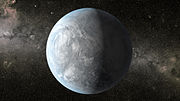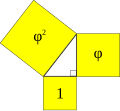Kepler-38 is a binary star system in the constellation Lyra. These stars, called Kepler-38A and Kepler-38B have masses of 95% and 25% solar masses respectively...
5 KB (306 words) - 04:17, 18 July 2024
Kepler-22b (also known by its Kepler Object of Interest designation KOI-087.01) is an exoplanet orbiting within the habitable zone of the Sun-like star...
19 KB (1,838 words) - 01:31, 23 October 2024
Johannes Kepler (/ˈkɛplər/; German: [joˈhanəs ˈkɛplɐ, -nɛs -] ; 27 December 1571 – 15 November 1630) was a German astronomer, mathematician, astrologer...
102 KB (12,606 words) - 08:45, 7 November 2024
Circumbinary planet (section Kepler-16)
(Kepler-16 A and PH1 Aa), star mass ratios from 1.03 to 3.76 (Kepler-34 and PH1), and binary eccentricity from 0.023 to 0.521 (Kepler-47 and Kepler-34)...
53 KB (5,613 words) - 12:00, 2 November 2024
Kepler-442b (also known by its Kepler object of interest designation KOI-4742.01) is a confirmed near-Earth-sized exoplanet, likely rocky, orbiting within...
18 KB (1,781 words) - 23:38, 25 May 2024
List of multiplanetary systems (redirect from Kepler-55)
with the most confirmed planets are the Sun (the Solar System's star) and Kepler-90, with 8 confirmed planets each, followed by TRAPPIST-1 with 7 planets...
264 KB (8,895 words) - 01:52, 10 November 2024
SN 1604, also known as Kepler's Supernova, Kepler's Nova or Kepler's Star, was a Type Ia supernova that occurred in the Milky Way, in the constellation...
16 KB (1,679 words) - 19:20, 17 October 2024
mechanics, Kepler's equation relates various geometric properties of the orbit of a body subject to a central force. It was derived by Johannes Kepler in 1609...
24 KB (3,577 words) - 08:47, 7 November 2024
27 R🜨), but a little smaller than Mercury (0.38 R🜨). Due to its small size, it is very likely Kepler-37b is a rocky planet with a solid surface. Furthermore...
11 KB (887 words) - 18:23, 24 July 2024
In classical mechanics, the Kepler problem is a special case of the two-body problem, in which the two bodies interact by a central force that varies in...
9 KB (1,558 words) - 12:11, 17 October 2024
Kepler-62e (also known by its Kepler Object of Interest designation KOI-701.03) is a super-Earth exoplanet (extrasolar planet) discovered orbiting within...
15 KB (1,400 words) - 21:00, 6 October 2024
Kepler-22 is a Sun-like star in the northern constellation of Cygnus, the swan, that is orbited by 1 planet found to be unequivocally within the star's...
10 KB (659 words) - 21:55, 24 August 2024
List of stars in Lyra (redirect from Kepler-105)
transiting planet (b) Kepler-440 19h 01m 24.0s +41° 27′ 08″ 15.5 851 has a transiting planet (b) Kepler-24 19h 21m 39s +38° 20′ 38″ 15.5 has two transiting...
33 KB (104 words) - 02:29, 10 November 2024
Kepler-62 is a K-type main sequence star cooler and smaller than the Sun, located roughly 980 light-years (300 parsecs) from Earth in the constellation...
17 KB (1,612 words) - 03:25, 3 November 2024
is host to exoplanets Kepler-37b, Kepler-37c, Kepler-37d and possibly Kepler-37e, all of which orbit very close to it. Kepler-37 has a mass about 80...
16 KB (1,411 words) - 05:26, 23 August 2024
Kepler mission (Kepler Candidates from the NASA Exoplanet Archive) that are potentially habitable. Those already confirmed are listed by their Kepler...
13 KB (326 words) - 22:11, 19 March 2024
A Kepler triangle is a special right triangle with edge lengths in geometric progression. The ratio of the progression is φ {\displaystyle {\sqrt {\varphi...
18 KB (2,047 words) - 22:57, 4 October 2024
Kepler-35 is a binary star system in the constellation of Cygnus. These stars, called Kepler-35A and Kepler-35B have masses of 89% and 81% solar masses...
9 KB (779 words) - 04:17, 18 July 2024
Kepler-409b is a super-Earth orbiting Kepler-409, a G-type main-sequence star. Its orbital period around the star is 69 days. Kepler-409b has a radius...
3 KB (267 words) - 01:59, 2 September 2024
Kepler-1649c is an Earth-sized exoplanet, likely rocky, orbiting within the habitable zone of the red dwarf star Kepler-1649, the outermost planet of...
10 KB (885 words) - 21:09, 14 January 2024
Kepler-9. Kepler-9c and Kepler-9b were the first exoplanets confirmed to be transiting their star. The planet's discovery was announced by the Kepler...
9 KB (765 words) - 19:30, 22 December 2023
proven a false positive by NASA in 2015. Several other KOIs, like Kepler-577b and Kepler-1649b, were considered potentially habitable prior to confirmation...
59 KB (3,204 words) - 14:49, 10 November 2024
Pepe (footballer, born 1983) (redirect from Kepler Laveran Lima Ferreira)
Kepler Laveran de Lima Ferreira ComM (born 26 February 1983), known as Pepe (Brazilian Portuguese: [ˈpɛpi], European Portuguese: [ˈpɛpɨ]), is a former...
74 KB (5,995 words) - 16:14, 3 November 2024
Kepler-20 is a star about 934 light-years (286 parsecs) from Earth in the constellation Lyra with a system of at least five, and possibly six, known planets...
17 KB (1,021 words) - 05:22, 23 August 2024
Kepler-296e (also known by its Kepler Object of Interest designation KOI-1422.05) is a confirmed super-Earth exoplanet orbiting within the habitable zone...
9 KB (854 words) - 22:42, 10 February 2024
This is a partial list of exoplanets discovered by the Kepler space telescope, running from star number 1 through 500, inclusive. All lists: 1–500 501–1000...
170 KB (2,916 words) - 06:55, 29 June 2024
In celestial mechanics, a Kepler orbit (or Keplerian orbit, named after the German astronomer Johannes Kepler) is the motion of one body relative to another...
42 KB (5,982 words) - 18:04, 20 December 2023
Kepler-442 is a K-type main-sequence star approximately 1,196 light years from Earth in the constellation Lyra. It is located within the field of vision...
12 KB (1,285 words) - 22:38, 15 July 2024
List of stars in Cygnus (redirect from Kepler-533)
Dennis; Zhou, Yixiao; White, Timothy R. (2020), "Asteroseismology of 36 Kepler subgiants – I. Oscillation frequencies, linewidths, and amplitudes", Monthly...
64 KB (298 words) - 13:26, 5 November 2024
Kepler-93b (KOI-69b) is a hot, dense transiting Super-Earth exoplanet located approximately 313 light-years (96 parsecs) away in the constellation of Lyra...
14 KB (1,113 words) - 10:49, 3 August 2024



















